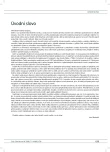Subacute Hypertensive Reversible Leukoencephalopathy – a Case Report
Authors:
A. Haluzová 1; R. Jura 1; J. Bednařík 1; S. Skutilová 1; T. Andrašinová 1; M. Keřkovský 2; A. Křivanová 3
Authors‘ workplace:
Neurologická klinika LF MU a FN Brno
1; Radiologická klinika LF MU a FN Brno
2; Interní kardiologická klinika LF MU a FN Brno
3
Published in:
Cesk Slov Neurol N 2008; 71/104(6): 726-731
Category:
Case Report
Overview
Hypertensive encephalopathy induced by essential or secondary arterial hypertension is characterised by a sudden onset of symptoms pointing to diffuse encephalopathy (headache, nausea, vomiting, vision problems, confusion or epileptic seizures) linked with an increase in blood pressure (BP, hypertensive crisis). In such case, the imaging methods applied, especially magnetic resonance (MR), show leukoencephalopathy. Both clinical symptoms and MR imaging findings are reversible after the blood pressure values have been normalised. We report a case of a 37-year old man who developed non-specific symptoms of encephalopathy over the period of one year (cephalea, vision disorders, behaviour changes, atactic walk). CT and MRI of the patient’s brain showed diffuse affection of the white matter of the brain, cerebellum and of the cerebral trunk. Inflammatory, demyelinisating, ischaemic, oncologic, metabolic and toxic aetiologies of leukoencephalopathy were excluded. In spite of absence of anamnestic data on arterial hypertension, and of normotensive values at admission, a hypertension crisis developed and clinical symptoms progressed into a picture of delirium. Blood pressure compensation resulted in the regression of clinical symptoms and a significant attenuation of cardiologic signs of encephalopathy, which was a confirmation of hypertensive etiology of leukoencephalopathy. Subsequently, the presence of chronic idiopathic arterial hypertension was confirmed, and secondary causes of hypertension including phaeochromocytoma were excluded. Hypertensive encephalopathy should be considered also in the case of protracted and fluctuating symptoms of encephalopathy and normal results for current blood pressure measurements.
Key words:
hypertensive encephalopathy – leukoencephalopathy
Sources
1. Lisá I, Lisý Ľ. Akútne leukoencefalopatie – diferenciálna diagnostika. Neurol pro praxi 2007; 8(2): 90–94.
2. Herzig R. Neurologické komplikace arteriální hypertenze. Interní Med 2003; 5: 11–15.
3. Václavík D, Školoudík D. Diagnostika postižení drobných mozkových tepen pomocí barevné transkraniální sonografie hodnocením rezistenčního indexu. Cesk Slov Neurol N 2004, 67/100(2): 99–103.
4. Mizra A. Posterior reversible encephalopathy syndrome: a variant of hypertensive encephalopathy. J Clin Neurosci 2006; 13: 590–595.
5. Williams GH. Hypertensive vascular disease. In: Braunwald E, Fauci AS, Kasper DL, Hauser, SL, Longo, DL, Jameson JL (eds). Harrison’s Principles of Internal Medicine. New York: McGraw-Hill 2001: 1428–1429.
6. Ambler Z, Bauer J. Cévní onemocnění mozku. In: Bednařík J, Ambler Z, Růžička E (eds). Klinická neurologie – část speciální. Praha: Triton 2008. In press.
7. Ducros A, Boukobza M, Porcher R, Sarov M, Valade D, Bousser MG. The clinical and radiological spectrum of reversible cerebral vasoconstriction syndrome. A prospective series of 67 patients. Brain 2007; 130(12): 3091–3101.
8. Hinchey J, Chaves C, Appignani B, Breen J, Pao L, Wang A et al. A reversible posterior leukoencephalopathy syndrome. N Engl J Med 1996; 334(8): 494–500.
9. Garg RK. Posterior leukoencefalopathy syndrome. Postgrad Med J 2001; 77(903): 24–28.
10. Thambisetty M, Biousse V, Newman NJ. Hypertensive brainstem encephalopathy: clinical and radiographic features. J Neurol Sci 2003; 208(1–2): 93–99.
11. Lee SY, Dinesh SK, Thomas J. Hypertension‑induced reversible posterior leukoencephalopathy syndrome causing obstructive hydrocephalus. J Clin Neurosci 2008; 15(4): 457–459.
12. Milia A, Moller J, Pilia G, Mascia MG, Marchi P, Mura M et al. Spinal cord involvement during hypertensive encephalopathy: clinical and radiological findings. J Neurol 2008; 255(1): 142–143.
13. Weingarten K, Barbut D, Filippi C, Zimmerman RD. Acute hypertensive encephalopathy: findings on spin‑echo and gradient-echo MR imaging. AJR Am J Roentgenol 1994;162(3): 665–670.
14. Donnan GA. Posterior leucoencephalopathy syndrome. Lancet 1996; 347(9007): 988.
15. Manger WM. An overview of pheochromocytoma: history, current concepts, vagaries, and diagnostic challenges. Ann NY Acad Sci 2006; 1073: 1–20.
16. Ay H, Buonanno FS, Schaefer PW, Le DA, Wang B, Gonzalez RG et al. Posterior leucoencephalopathy without severe hypertension: utility of diffusion-weighted MRI. Neurology 1998; 51(5): 1369–1376.
Labels
Paediatric neurology Neurosurgery NeurologyArticle was published in
Czech and Slovak Neurology and Neurosurgery

2008 Issue 6
Most read in this issue
- Multiple Sclerosis and Magnetic Resonance Imaging: Present Status and New Trends
- Adult Age Sleep Apnoea
- Subacute Hypertensive Reversible Leukoencephalopathy – a Case Report
- Protein 14-3-3 Detection in Cerebrospinal Fluid – Clinico-Pathological Correlation
